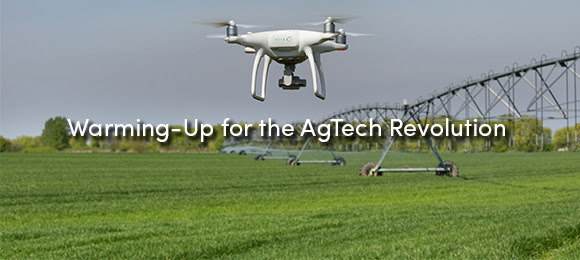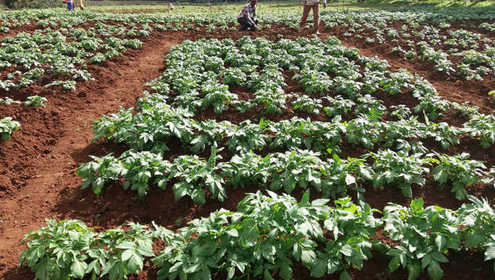
Beginnings of agriculture reach far back into human history when first civilizations turned from hunting and gatherer life to cultivation of plants and animals. Throughout its entire history, agriculture was known as a labor-intensive activity.
Besides sunlight, water, and nutrients, growing crops also requires certain energy for managing farm activities such as soil preparation, planting or sowing, crop protection, fertilization, harvest, and many others. Back in the day, farmers were utilizing energy just by using their own hands and simple farming tools such as sticks. With the invention of the plow and other farming implements, farmers started to utilize the energy of animals, which significantly facilitated everyday farm activities.

Invention That Drives Significant Changes
The invention of a tractor, which occurred at the beginning of the 19th century revealed many new possibilities for farmers. By replacing animals with gas or diesel engine tractors, the agriculture has experienced significant changes. Farmers finally had the opportunity to manage their production more efficiently, thus reducing manual labor.

The invention of the first tractor has also triggered the development of an entire industry of farm machinery. In just a few decades after the introduction of the first tractor, a whole range of farming implements occurred on the market.
Technology Is Taking over the Agriculture
With rapid technological development, tractors have experienced the technological spotlight. In other words, simple tractors evolved into fully equipped machines that provide maximum comfort to a farmer. Improved and user-friendly driving consoles, together with large and air-conditioned cabins, have become integral components of modern tractors. At this point in agriculture, every improvement was oriented towards a farmer. Making farmer's life easier through modernization of farm machinery was the main focus of machinery producers.

What's even better is that these improvements are just the beginning of the revolution in farm technology, which culminated with the occurrence of the GPS system. As one of the most utilized types of a satellite system, the global positioning system (GPS) enables accurate driving and application in the field. Moreover, precise navigation with a GPS system marked the beginning of a new era in farm management, known as precision farming.

Agtech revolution, encouraged by the occurrence of the GPS system, continued with its strong development during the last few decades. Today, modern tractors include autosteering systems which enable automated and accurate guidance of a vehicle, thus minimizing field overlapping and underlapping. That way, the autosteering system allows a farmer to focus on managing a farm activity, instead of steering the vehicle.
Besides that, the agriculture has experienced a development of various sensors and remote sensing technology. Sensors are devices that measure various crop or soil conditions. On the other hand, remote sensing technology includes drones, satellites, and airplanes that use the sensors to obtain various information about crops and soil conditions from a distance.
By using farm sensors, attached to a remote sensing technology and in conjunction with a GPS system, a farmer can create soil maps. The process that enables creating maps about various soil and crop conditions (soil nutrient levels, pH value, pest occurrence, and others) is also known as geo-mapping. Sensors can also be attached to a tractor, combine or some other farming implement. For instance, yield mapping sensors installed on the combine, collect the data about the yield and other crop characteristics during the harvest.

Another revolutionary change in agriculture was the development of variable rate technology that provides the application of the right amount of inputs, in the right location on the field, and at the right time.
While the tractor passes over the field, the sensor gathers the data which can be processed in two ways:
- The data is immediately delivered to the farm equipment responsible for the application (i.e. agricultural sprayer)
- The data is delivered in the form of a soil map that needs to be processed before its further delivery to the farm equipment responsible for the application.
This means that inputs such as seeds, fertilizers, pesticides, and water can be distributed based on the requirements of each part on the field.
Besides aforementioned technologies, Wi-Fi connection has also revealed endless possibilities in farm management. Thanks to that, the device (mobile phone, tablet, computer) and the tractor, can easily become one farm management unit.

The AgTech Revolution Expands Industry Boundaries
Parallel with the development of modern tractors and precision farming technology, other aspects of farm machinery have experienced the agtech revolution as well. By expanding its technological boundaries, modern agriculture has become precise and data-driven.
This new angle of farming expands industry boundaries and brings a fresh perspective on all types of farm machinery, including the following:
- soil management implements
- planters and sowing machines
- agricultural sprayers
- fertilizer spreaders
- irrigation systems
- combines
- storage and packing facilities
- drones and satellite imagery
- farm management software.

In other words, a simple tractor has evolved into a whole agtech system that is mutually interconnected with other technological aspects of farm management (including a weather station, irrigation technology, various farming implements, and finally, farm management software).

Regarding the fact that agtech is just heating up, the only question is: What the future brings? Robotic harvesters, in-door farming, self-driving tractors, farm management software, and many other new technologies are just about to start changing the way food is produced.
The changes in agriculture aren't happening slowly anymore. Technology is extending all boundaries. Now, it's up to a farmer to join the ride and keep up with all those changes in order to improve his farming.
Sources: Agrivi












Comments (1)
Login or Register to add a comment